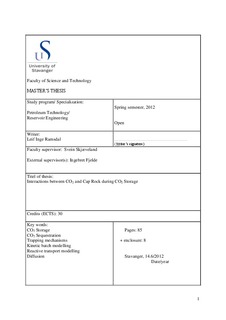| dc.contributor.author | Ramsdal, Leif Inge | |
| dc.date.accessioned | 2012-11-20T12:53:52Z | |
| dc.date.available | 2012-11-20T12:53:52Z | |
| dc.date.issued | 2012 | |
| dc.identifier.uri | http://hdl.handle.net/11250/183458 | |
| dc.description | Master's thesis in Petroleum engineering | no_NO |
| dc.description.abstract | Geological sequestration and storage of carbon dioxide is a viable method for mitigating anthropogenic emissions of fossil fuels into the atmosphere. Geochemical reactions play an important role in CO2 storage environments because they may change the properties of the overlying cap rock, and can either enhance or degrade the storage capacity and feasibility of a CO2 storage project. Geochemical models can simulate these interactions and provide important knowledge of the feasibility of a CO2 storage project at different settings.
In this thesis the geochemical simulation tool PHREEQC is used to simulate CO2-rock-brine interactions at two distinct sites, Nordland Shale and Frio Shale. Both kinetic batch modelling and reactive transport modelling were conducted. Kinetic batch modelling results show that mineral dissolution and precipitation reactions is strongly related to the presence of carbon dioxide in the cap rock. Carbonate minerals precipitate as a consequence of the dissolution of CO2. When CO2 dissolves some of it will be permanently trapped in the precipitating carbonates in a process referred to as mineral trapping. Silicate dissolution or precipitation is also seen as a strong function of the behaviour of CO2. Albite dissolution is the main mechanism for silicate precipitation at both storage sites.
Reactive transport modelling results indicate that the first 5-10 meters are affected by diffusive transport for the Nordland Shale formation, whereas the first 20-25 meters of the cap rock are affected by diffusive transport for the Frio Shale formation. This indicates that porosity and permeability of the lower cap rock are altered. Mineralogical changes within the area affected by diffusive transport are significantly larger for Nordland Shale compared to Frio Shale. Future studies should include advection transport to investigate the effects a flow rate would have on the cap rock mineralogy. | no_NO |
| dc.language.iso | eng | no_NO |
| dc.publisher | University of Stavanger, Norway | no_NO |
| dc.relation.ispartofseries | Masteroppgave/UIS-TN-IPT/2012; | |
| dc.subject | CO2 storage | no_NO |
| dc.subject | reactive transport modelling | no_NO |
| dc.subject | diffusion | no_NO |
| dc.subject | PHREEQC | no_NO |
| dc.subject | kinetic batch modelling | no_NO |
| dc.subject | trapping mechanisms | no_NO |
| dc.subject | CO2 sequestration | no_NO |
| dc.subject | petroleumsteknologi | no_NO |
| dc.subject | reservoarteknologi | no_NO |
| dc.title | Interactions between CO2 and cap rock during CO2 storage | no_NO |
| dc.type | Master thesis | no_NO |
| dc.subject.nsi | VDP::Technology: 500::Rock and petroleum disciplines: 510::Petroleum engineering: 512 | no_NO |
